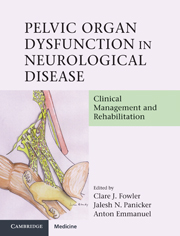Crossref Citations
This Book has been
cited by the following publications. This list is generated based on data provided by Crossref.
Johnson, Ian P
2012.
Colorectal and uterine movement and tension of the inferior hypogastric plexus in cadavers.
Chiropractic & Manual Therapies,
Vol. 20,
Issue. 1,
Vodušek, David B.
2014.
Lower Urinary Tract and Sexual Dysfunction in Neurological Patients.
European Neurology,
Vol. 72,
Issue. 1-2,
p.
109.
Tanaka, Kanta
Shitara, Satoshi
Wada, Ikko
Shima, Atsushi
Okunomiya, Taro
and
Suenaga, Toshihiko
2014.
A case of medullary infarction of characteristic distribution that developed mainly with lower urinary tract dysfunction.
Nosotchu,
Vol. 36,
Issue. 6,
p.
438.
Michels, Lars
Blok, Bertil F.M.
Gregorini, Flavia
Kurz, Michael
Schurch, Brigitte
Kessler, Thomas M.
Kollias, Spyros
and
Mehnert, Ulrich
2015.
Supraspinal Control of Urine Storage and Micturition in Men—An fMRI Study.
Cerebral Cortex,
Vol. 25,
Issue. 10,
p.
3369.
Al Awlaqi, Ahmed
Alkhayat, Khalid
Akrawi, Guvan
Al Awlaqi, Nasser
and
Hammadeh, Mohamed E
2016.
Hormone Profile in Hypersexuality Women.
International Journal of Women's Health and Reproduction Sciences,
Vol. 4,
Issue. 2,
p.
52.
El-Sakka, Ahmed I.
2017.
The Textbook of Clinical Sexual Medicine.
p.
169.
Tudor, Katarina Ivana
and
Panicker, Jalesh N.
2017.
Male Sexual Dysfunction.
p.
220.





